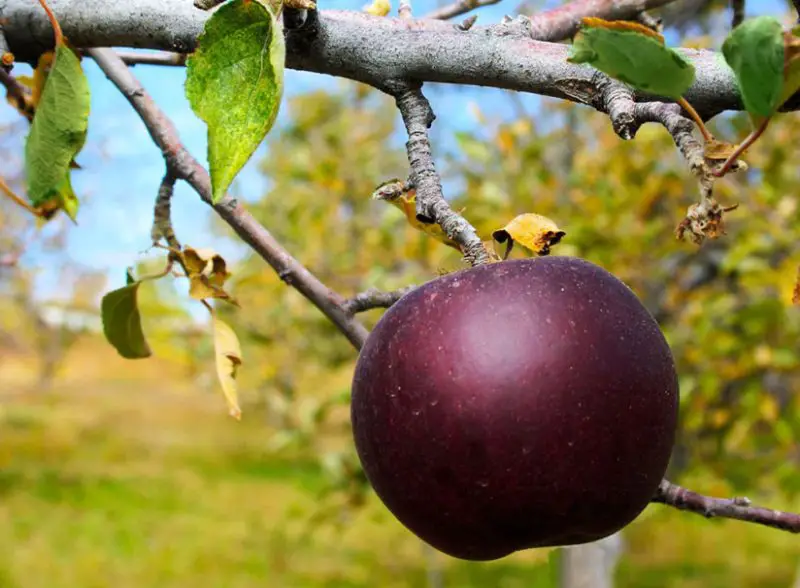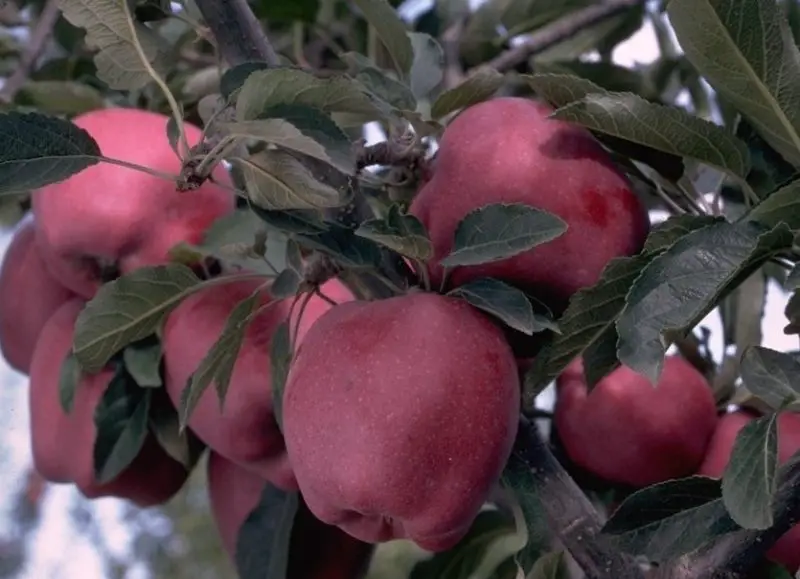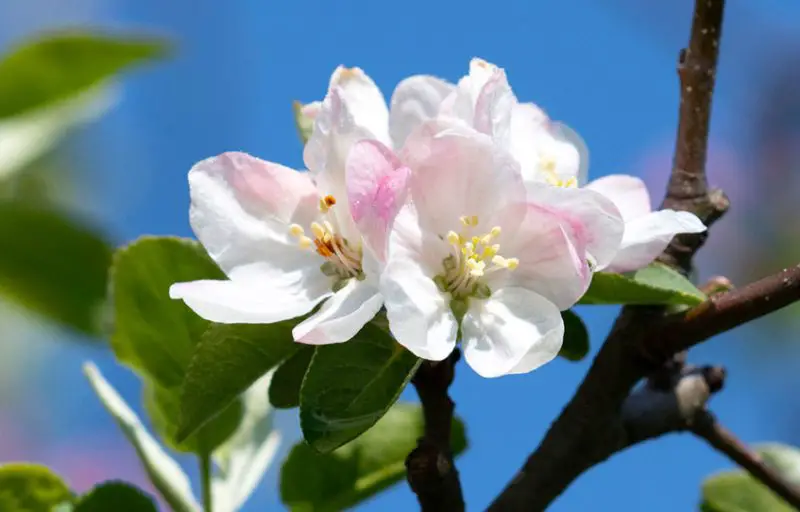The Arkansas black apple tree, with its striking dark fruit and sturdy appearance, attracts the attention of gardeners. This plant is native to temperate climates (Arkansas, USA). From beautiful flowers to a desirable harvest, the Arkansas black apple tree brings high economic value to farmers here.
Continue reading the article below to learn about the origin, characteristics, and instructions on how to grow this delicious apple.
About Arkansas Black Apple Tree

Originating in Benton County, Arkansas, during the mid-19th century, the Arkansas Black apple tree variety has earned widespread acclaim for its unique characteristics.
The Arkansas Black apple tree produces fruit with a deep crimson to almost black color, crisp, crunchy flesh, and a waxy skin. Its flavor profile is a well-balanced combination of sweetness and acidity, which makes it a popular addition to baked goods and cider recipes.
The Arkansas Black apple tree is incredibly hardy and can withstand a wide variety of weather conditions, including scorching summers and icy winters. It differs from other types in that it blossoms later, making it less susceptible to spring frost damage.
Preferred by both commercial orchards and home gardeners, this tree exhibits resistance to various apple diseases, enhancing its appeal and ease of cultivation.
Thanks to its long shelf life and usual harvest time in October, the fruit from the Arkansas Black apple tree is favored for winter culinary pursuits, lending its delicious essence to a variety of baked goods and savory dishes.
Origin and characteristics of Arkansas Black Apple Tree

Origin
The Arkansas Black Apple Tree, with its origins tracing back to the heart of Arkansas in the mid-19th century, holds a special place in the annals of American horticulture. While the precise genesis of these trees remains shrouded in mystery, local lore suggests they emerged serendipitously as a chance seedling in Benton County, Arkansas. From this humble beginning, the apple tree captivated the imaginations of local farmers, who recognized its potential and began propagating it with fervor.
Distinguished by its late-season harvest, typically occurring in the crisp month of October, the Arkansas Black apple stands out for its distinctive appearance and exceptional flavor profile. Each medium-sized fruit boasts a rich, dark red to black hue when fully ripened, signaling its readiness for picking. Cutting into its firm, crisp flesh reveals a tantalizing blend of sweetness and tartness, a sensory delight for apple enthusiasts.
Yet, perhaps what truly sets the Arkansas Black apple apart is its remarkable ability to endure the test of time. Renowned for its exemplary storage qualities, this apple can withstand the rigors of up to six months in storage without compromising its flavor or texture. This longevity not only ensures a steady supply of fresh apples throughout the winter months but also solidifies its status as a beloved staple among growers and consumers alike.
The Arkansas Black Apple Tree was soon introduced to other parts of the United States after becoming popular among Arkansas’s farmers. In the early 1900s, apple producers in California adopted it due to its unique flavor and remarkable preservation capacity.
These days, the famous apple tree may be seen growing in several states in the US, including California, Washington, Oregon, and New York. Its appeal is widespread; exports are made to nations like Japan and Canada.
In essence, the Arkansas Black Apple Tree, with its storied history and unique attributes, has become a cherished symbol of American horticulture, beloved both domestically and abroad.
Characteristics
Arkansas Black apple trees stand out in orchards all throughout the country thanks to their unique set of physical characteristics. These trees are medium-sized, have a spreading growth habit, and have medium-sized, oval-shaped leaves with dark, rough bark. Their blossoms, which open in springtime in colors of white or soft pink, add an air of ethereal beauty to the surroundings.
The fruit of the Arkansas Black apple tree is equally striking. Approximately medium in size and round or slightly oblong, the apples have dark crimson to almost black skin that is infused with a waxy texture that enhances their appeal. Underneath this black outer layer comes vivid yellow flesh that is solid and bite-friendly.
Arkansas Black Apple Tree Growing Guide

Although it can be a gratifying task, growing Arkansas Black apple trees involves paying close attention to a few crucial elements in order to assure optimal development and fruit output. Here’s a basic how-to to get you going:
Climate and Location
Arkansas Black apple trees flourish in temperate climates boasting distinct seasons. Essential for their growth is abundant sunlight, necessitating exposure to 6-8 hours daily. Optimal planting sites must feature well-draining soil to avert waterlogging and the consequential root rot. Careful consideration of these factors ensures the health and vitality of these trees, enabling them to produce their renowned, crisp fruit.
Soil Preparation
Before planting, it’s crucial to prepare the soil meticulously. Enhance its quality by integrating organic matter like compost or aged manure, enriching both structure and fertility. Conduct a soil test to gauge pH levels, adjusting them accordingly to achieve an optimal slightly acidic range of 6.0 to 7.0. This meticulous soil preparation lays the groundwork for healthy root development and robust growth, setting the stage for flourishing plants and abundant harvests in the seasons to come.
Planting
For optimal results, plant Arkansas Black apple trees during late winter or early spring, when they’re dormant. Dig a hole slightly bigger than the root ball, ensuring the graft union (if present) sits 2-3 inches above the soil surface. Fill the hole with soil, gently packing it around the roots, then water generously. This careful planting process establishes a strong foundation for the tree, fostering healthy growth and setting the stage for future seasons of abundant fruit production.
Watering
Newly planted Arkansas Black apple trees necessitate consistent watering to facilitate root establishment. Employ deep, infrequent watering techniques, maintaining soil moisture without inducing waterlogging. As the trees mature, they develop moderate drought tolerance, yet supplemental irrigation, particularly during dry summer spells, can bolster their health and productivity.
Fertilization
In early spring, before new growth emerges, administer a balanced fruit tree fertilizer to your Arkansas Black apple trees. Adhere to the manufacturer’s guidelines for application rates, tailored to the size and age of your trees. Be cautious of excessive nitrogen fertilization, as it may prioritize vegetative growth over fruit production. A balanced approach ensures optimal nutrition, fostering healthy trees and bountiful harvests.
Pruning
Annual pruning of Arkansas Black apple trees during dormancy enhances airflow, light penetration, and fruit yield. Trim away dead, diseased, or crossing branches to maintain tree health. Shape the tree into a central leader or open-vase form to stimulate balanced growth. Thoughtful pruning practices ensure optimal tree structure and maximize the potential for a fruitful harvest each year.
Pest and Disease Management
Regular monitoring is essential for effective pest and disease management in Arkansas Black apple trees. Watch for common pests like aphids, mites, and codling moths, along with diseases such as apple scab and powdery mildew. Utilize cultural practices like sanitation, correct pruning, and timely pest control to reduce infestations and diseases. Opt for organic or integrated pest management strategies whenever feasible to maintain tree health and minimize environmental impact.
Harvesting
Arkansas Black apples typically ripen in late fall, usually around October. Harvest when the fruits display their full color and firmness, gently twisting them to detach from the tree. To extend shelf life, store the harvested apples in a cool, humid environment. This ensures that the fruit remains fresh and flavorful for an extended period, allowing for enjoyment well beyond the harvest season.






